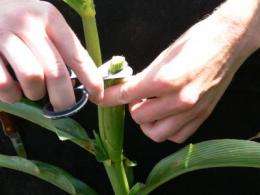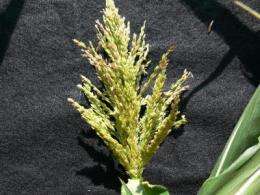Doubled haploid technology for quickly developing inbred corn lines offered at ISU

Agronomists at Iowa State University are offering doubled haploid technology that allows corn breeders to more quickly produce inbred lines for research or private use.
Thomas Lübberstedt, associate professor and K.J. Frey chair in agronomy and director of the R.F. Baker Center for Plant Breeding, has launched a Doubled Haploid Facility at ISU that can develop pure, inbred corn lines in less time than traditional methods.
Inbred corn lines have two copies of the same genome. They are sometimes called pure lines, because after self-pollination (same plant is both male and female) all offspring are identical to the parent plant. They are an exact replica of the single parent and are valuable for research or commercial use.
These homozygous plants have two identical copies per gene, while heterozygous plants, such as hybrids, frequently have two different copies per gene.
Offspring of hybrids are genetically segregating because they received their two genomes from different male and female plants. This is the reason why hybrid seed has to be reproduced from stably maintained inbred plants. Corn crop produced from seed that has not been harvested from hybrids will not only segregate but also show reduced hybrid vigor.
"If you want to develop new inbred lines, you would start out with a plant that is heterozygous. Then by self-pollination you can increase the homozygosity each generation. But you need maybe five to eight generations before you have an inbred line that is pure enough so that you can combine two inbred lines to create such a hybrid," Lübberstedt said.
The Doubled Haploid Facility at ISU will allow development of pure, inbred lines in only two generations, taking about one year.
"With the doubled haploid process, you start from the same place, but by a biological trick, the offspring do not contain two genomes as usual, but only one. Then you have a chemical treatment, and after that, plants have two identical genomes, so you can get to the inbred lines much faster," said Lübberstedt.
While major breeding companies often develop their own pure lines in-house and may not need the Doubled Haploid Facility at Iowa State, smaller hybrid companies and researchers are more likely to need the facility's expertise.
The first group of users of the Doubled Haploid Facility includes researchers from both public and private groups from ISU, the United States and overseas.
One of the components of the process is a special type of corn called an inducer line. The inducer line Lübberstedt is using comes from Germany. In collaboration with the United States Department of Agriculture's Plant Introduction Station in Ames, he is currently working on developing a new inducer line that will be better suited to climate conditions in Iowa.

Purebred corn lines are also valuable to researchers as a tool to isolate individual gene functions.
"If you want to find genome regions that are associated with disease resistance or something like that, the procedure is that you develop a segregating population. If the offspring are homogenous lines, then you can better discriminate between different genetic lines because there is no genetic noise any longer within those lines," said Lübberstedt.
If there is a demand for the Doubled Haploid Facility, Lübberstedt believes they could include other plants in the future.
"Here in the Midwest, our entry point is corn," Lübberstedt said. "But it may be of interest for other species, such as soybean or energy grasses at some point."
Provided by Iowa State University


















